
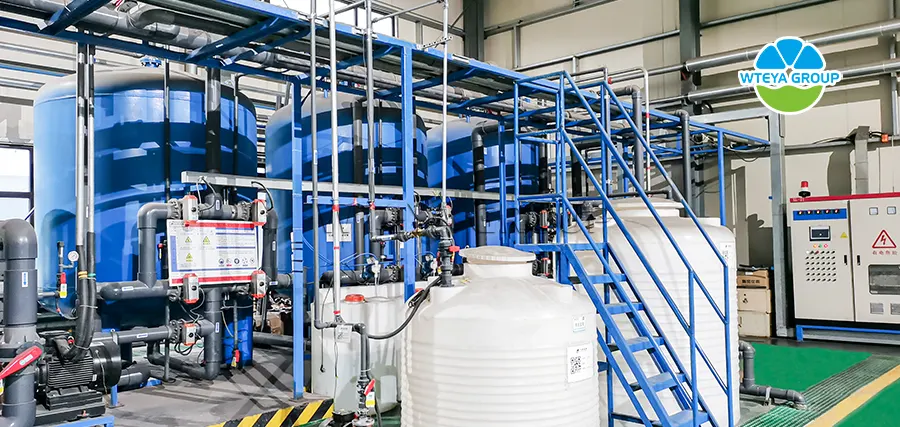
1. Multi media/activated carbon filtration system:
Applied in which production process
Multi media filters are usually used as the initial stage of water treatment, which effectively remove impurities such as suspended solids, colloids, and particles in water through the combination of different media, providing a relatively clean water source for subsequent treatment processes. This step is of great significance for protecting subsequent processing equipment and improving overall processing efficiency.
Activated carbon filters are mainly used to remove impurities such as organic matter, odors, and pigments from water. Activated carbon has strong adsorption capacity, which can adsorb and remove these pollutants in water, thereby further improving the purity of water quality. This step is crucial for ensuring the quality and stability of ultrapure water.
By combining multimedia filters and activated carbon filters, most impurities in water can be effectively removed, providing a good water quality foundation for subsequent advanced treatments such as reverse osmosis and ion exchange. This helps to ensure the quality and stability of ultrapure water required in the production process of the electronic semiconductor industry, thereby improving product performance and reliability.
Technical Principles
The technical principle of multimedia filters is mainly to use one or more filtering media to remove suspended impurities in water through deep filtration. When the raw water passes through the filter material from top to bottom, larger particles are removed at the top layer, while smaller particles are removed deeper in the filter medium. This mainly depends on the adsorption and mechanical blocking effect of the filter material layer, as well as the compactness of the sand particle arrangement, which gives water particles more opportunities to collide with the sand particles and be intercepted. After such treatment, the suspended solids in the effluent can be controlled at a lower level to ensure the clarity of the water quality.
The technical principle of activated carbon filters is mainly based on the adsorption effect of activated carbon. Activated carbon has a large surface area and complex pore structure, which gives it strong adsorption capacity. When water passes through an activated carbon filter, pollutants such as organic matter, odors, and pigments in the water will be adsorbed on the surface of the activated carbon, thus being effectively removed. In addition, activated carbon can also remove residual chlorine from water, ensuring the normal operation of subsequent treatment equipment.
What effects can we achieve
Firstly, as a pre-treatment equipment, the design of a multimedia filter with multiple media combinations enables it to effectively remove large impurities such as suspended solids and particulate matter from water. This is crucial for protecting subsequent water treatment equipment and processes, ensuring the stable operation of the entire water treatment system. Through this step, a preliminary purified water source can be provided for the electronic semiconductor industry, reducing the potential impact of impurities on the production process.
Secondly, activated carbon filters utilize their strong adsorption capacity to further remove trace impurities such as organic matter, odors, and pigments from water. If these impurities are not removed, they may have adverse effects on the quality and performance of electronic semiconductor products. The application of activated carbon filters can significantly improve the purity of water sources and meet the strict requirements of the electronic and semiconductor industry for high-quality water quality.
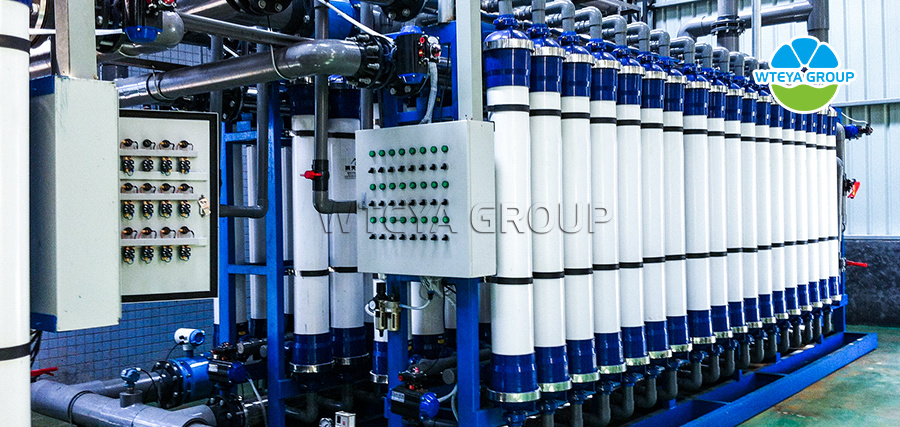
2. Ultrafiltration system:
Applied in which production process
Firstly, in the cleaning process, ultrafiltration membranes can effectively remove particles and ions from water, serving as a pre-treatment process for high-quality ultrapure water systems. This ultrapure water is used to clean semiconductor devices and equipment to ensure the cleanliness of product surfaces and avoid the impact of pollutants on product performance and reliability.
Secondly, ultrafiltration technology is also commonly used in the preparation of process liquids. In the semiconductor manufacturing process, various process liquids such as acids, bases, organic solvents, etc. need to be used. Ultrafiltration membranes can filter and purify these liquids, remove impurities and particles, and ensure that the purity and quality of the liquid meet production requirements.
In addition, ultrafiltration technology also plays an important role in the cooling water circulation of equipment. Semiconductor manufacturing equipment generates a large amount of heat during operation and requires cooling water for heat dissipation. Ultrafiltration membrane can remove particles and ions from cooling water, prevent impurities from causing damage to equipment, and ensure the normal operation of equipment and product stability.
Technical Principles
The technical principle of ultrafiltration is mainly based on a pressure driven membrane separation process. The core lies in using a semi permeable membrane with a specific pore size, namely an ultrafiltration membrane, to intercept colloids, particles, and substances with relatively high molecular weight in water, while water and small solute particles can penetrate the membrane.
The pore size of ultrafiltration membranes is usually between 20 and 1000A °, with a filtration range of 0.002 μ m to 0.2 μ m, which can effectively intercept particles with a diameter greater than 0.002 μ m, such as proteins, pectin, fats, and microorganisms. Ultrafiltration membranes with different materials and structures have different separation effects and application ranges, so it is necessary to choose the appropriate ultrafiltration membrane according to specific application requirements. Meanwhile, operating conditions such as applied pressure, flow rate, and temperature can also have an impact on the filtration efficiency of ultrafiltration, and optimization control is needed.
What effects can we achieve
Firstly, the ultrafiltration system can provide high-purity process water. In the manufacturing process of electronic semiconductors, there is a high requirement for water quality, and any small impurities may have a serious impact on product quality and performance. The ultrafiltration system, through its efficient filtration ability, can effectively remove particles, colloids, bacteria, and other impurities from water, ensuring the purity of process water and meeting the high standard requirements for water quality in electronic semiconductor manufacturing processes.
Secondly, ultrafiltration systems can protect production equipment. Due to the ability of ultrafiltration systems to provide pure process water, it helps to reduce corrosion and scaling in production equipment caused by water quality issues, thereby extending the service life of the equipment and reducing maintenance costs.
In addition, ultrafiltration systems can also help improve production efficiency. By ensuring the quality and stability of process water, ultrafiltration systems can reduce production interruptions and product quality fluctuations caused by water quality issues, thereby ensuring the continuity and stability of the production process and improving production efficiency.
Finally, ultrafiltration systems also contribute to achieving environmental protection and sustainable development. By effectively removing pollutants from water, ultrafiltration systems can reduce the difficulty and cost of wastewater treatment, and minimize their impact on the environment. At the same time, the application of ultrafiltration systems also helps to promote the transformation of the electronic semiconductor industry towards more environmentally friendly and sustainable production methods.
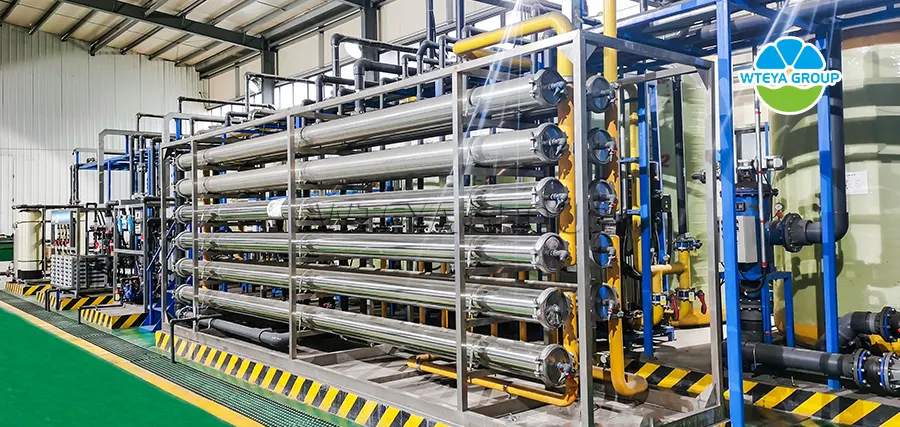
3. Reverse osmosis membrane system:
Applied in which production process
Reverse osmosis membranes are mainly used in the semiconductor industry for the process steps of preparing ultrapure water. In the manufacturing process of electronic semiconductors, ultrapure water is widely used to clean key components such as silicon wafers and chips, effectively removing surface particles and organic matter, and reducing product defect rates. Reverse osmosis membranes can provide stable and low tension deionized water, meeting the high water quality requirements of the semiconductor industry.
In addition, reverse osmosis membrane technology can also provide high-quality cleaning water, ensuring the reliability and stability of components. By utilizing the characteristics of reverse osmosis membranes, precise control of water quality can be achieved, meeting the strict requirements for ultrapure water in electronic semiconductor manufacturing processes.
Technical Principles
Reverse osmosis membrane is usually a artificially synthesized semi permeable membrane with a very small pore size, which can effectively intercept impurities such as soluble salts, organic matter, and heavy metal ions in water, while allowing water molecules to pass through. If a pressure greater than osmotic pressure is applied on one side of the concentrated solution, the flow direction of the solvent will be opposite to the original osmotic direction, starting to flow from the concentrated solution to the dilute solution side. This process is called reverse osmosis. At this point, the solvent passes through the reverse osmosis membrane under pressure, while the solute is intercepted by the membrane, achieving the purpose of separation and purification.
What effects can we achieve
Firstly, reverse osmosis membranes can efficiently remove impurities such as bacteria, organic matter, and metal elements from water, ensuring the quality and stability of ultrapure water. This high-purity water is indispensable in the manufacturing process of electronic semiconductors, used to clean key components such as silicon wafers and chips, effectively remove surface particles and organic matter, reduce product defect rates, and thereby improve product quality and performance.
Secondly, the application of reverse osmosis membrane technology has slowed down the changes in the production water quality caused by fluctuations in the source water quality, thereby facilitating the stability of water quality in production. This has a positive effect on the stability of the quality of ultrapure water products and helps to ensure the qualified production of semiconductor products.
In summary, the application of reverse osmosis membranes in the electronic semiconductor industry can achieve efficient preparation of ultrapure water, ensure the stability and reliability of product quality, and also help reduce production costs and environmental pollution.
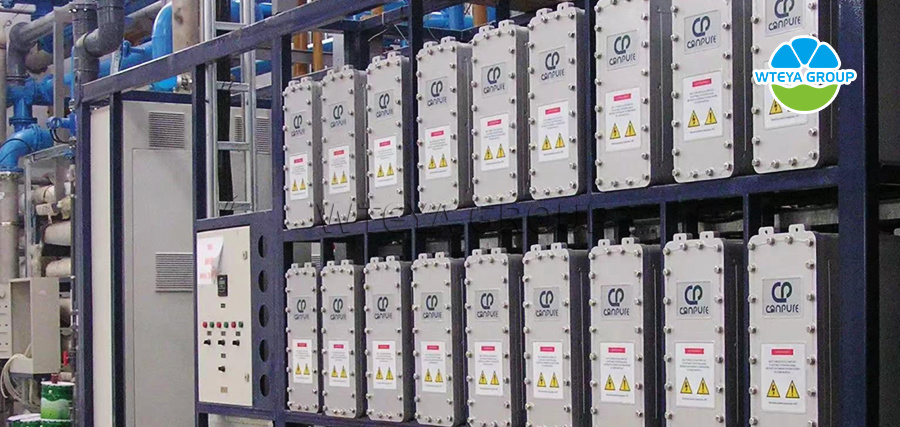
4. EDI system:
Applied in which production process
EDI systems, also known as electrodeionization systems, have a wide range of applications in the semiconductor industry. It is mainly used in the process steps of preparing ultrapure water.
In the semiconductor manufacturing process, ultrapure water is used in multiple key process steps, such as cleaning key components such as silicon wafers and chips, as well as serving as the basis for preparing other process liquids. The EDI system can effectively remove ions and other impurities from water through ion exchange membrane technology and ion electromigration technology, thereby preparing high-purity ultrapure water.
Specifically, EDI systems can remove ions from water, such as metal ions such as sodium, calcium, magnesium, as well as anions such as chloride and sulfate ions, resulting in extremely low water conductivity and meeting the high requirements for water quality in semiconductor manufacturing processes. Meanwhile, due to its efficient ion removal ability, EDI systems can also reduce the regeneration frequency and chemical consumption required in traditional ion exchange processes, reducing operating costs and environmental impacts.
Technical Principles
The technical principles of EDI systems are mainly based on ion exchange membrane technology and ion electromigration technology.
Under the action of a direct current electric field, the dielectric ions in the partition of the EDI system undergo directional movement. Ion exchange membranes have selective permeability to ions, allowing certain ions to pass through while preventing others from passing through, thereby achieving purification of water quality. In this process, the ion exchange resin is continuously regenerated by electricity, so there is no need to use acid and alkali for regeneration.
Specifically, the EDI module sandwiches ion exchange resin between anion/cation exchange membranes to form EDI units, which are separated by grids to form a concentrated water chamber and a fresh water chamber. After setting up negative/positive electrodes at both ends of the unit group, direct current drives the negative and positive ions in the fresh water chamber to pass through the corresponding ion exchange membranes and enter the concentrated water chamber, thereby removing these ions in the fresh water chamber. The water in the concentrated water chamber carries ions out of the system, forming concentrated water.
What effects can we achieve
The EDI system can efficiently prepare ultrapure water. In the semiconductor manufacturing process, ultrapure water is a key production factor used for cleaning core components such as silicon wafers and chips, as well as serving as the basis for preparing other process liquids. The EDI system, through its efficient ion removal ability, can remove impurities such as ions and organic matter from water, ensuring the quality and stability of ultrapure water and meeting the high requirements of semiconductor manufacturing for water quality.
Moreover, the EDI system has the advantages of simple operation, no need for regeneration, and stable effluent water quality. While meeting the requirements of inflow, it can ensure that the electrical resistivity of continuous water production is ≥ 15M Ω.
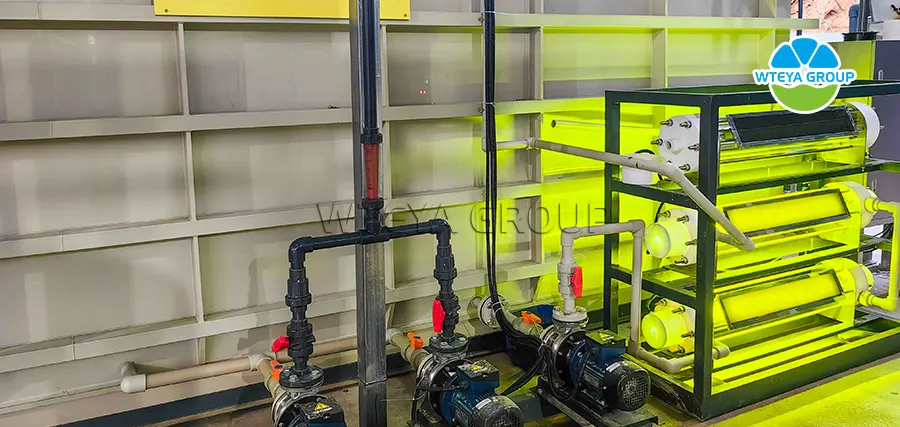
5. Polishing mixed bed system:
Applied in which production process
Polishing mixed beds are mainly used in the semiconductor industry for the preparation process of ultrapure water.
Chip washing: During the manufacturing process of chips, various impurities are generated through processes such as chemical/physical precipitation, corrosion, and baking. To remove these impurities and ensure chip performance, it is necessary to use ultrapure water for washing.
Preparation of semiconductor materials: Ultra pure water can remove impurities from the surface of semiconductor materials, ensuring the purity requirements of semiconductor materials, thereby effectively improving the performance and reliability of semiconductor chips.
In these process steps, ultrapure water is used to clean semiconductor devices and equipment, ensuring the cleanliness of product surfaces and avoiding the impact of pollutants on product performance and reliability. The polishing mixed bed system can effectively remove ions and organic matter from water, ensuring that the water quality meets high standards in the semiconductor industry.
Technical Principles
The technical principle of polishing mixed bed is mainly based on the principle of ion exchange. This resin is a polymer compound composed of special ion exchange groups that can exhibit ion exchange function in aqueous solutions.
In the application of the semiconductor industry, polishing mixed beds are mainly used for the preparation of ultrapure water. When the raw water containing impurity ions passes through the resin, the ion exchange groups in the resin will exchange with these impurity ions, adsorb them on the resin, and release ions that are harmless to the process. In this way, through the ion exchange interaction of the resin, impurity ions in the raw water are effectively removed, resulting in high-purity water.
What effects can we achieve
Firstly, it ensures the quality of ultrapure water. Ultra pure water is crucial in the manufacturing process of electronic semiconductors. Polishing mixed bed can efficiently remove ions, organic matter, and other impurities from water, ensuring the quality and stability of ultrapure water, and meeting high standards for water quality in electronic semiconductor manufacturing.
Polishing the mixed bed also helps to improve production efficiency. Due to its efficient ion exchange capacity and stable performance, it can reduce production interruptions and equipment maintenance caused by water quality issues, ensuring the continuity and stability of the production process.
Get a free quote!
Let professionals help you choose
Our Customers And Services










